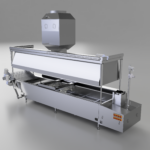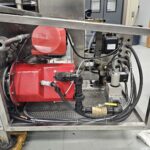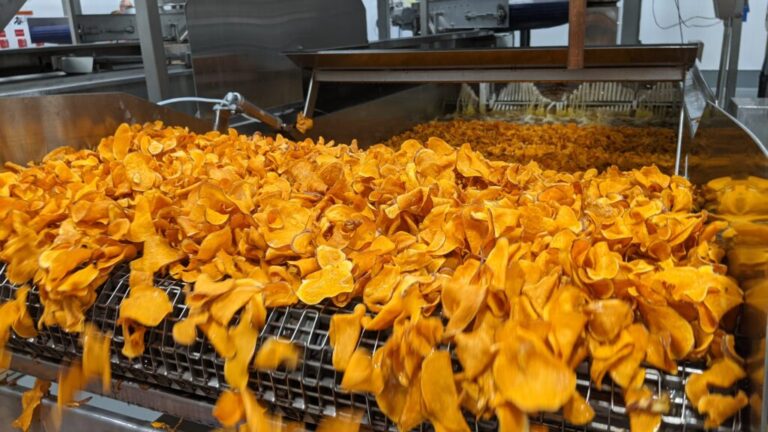In the highly competitive snack food manufacturing industry, productivity and efficiency are of paramount importance. JD Manufacturing Co., Ltd. (JDM) of Pine Bluffs, Wyoming leads the industry with high performance automated batch fryers designed specifically for kettle chip production. The batch frying process gives kettle chips a unique, premium texture and flavor whether they are made with potatoes, sweet potatoes, parsnips, carrots, beets or anything else.
JDM has a large global footprint with approximately 160 systems in operation across five continents. JDM fryers feature an innovative heat exchanger design that allows for high production capacity. However, this advanced design places a significant load on the blower.
Industry-leading power density
To meet these demands, JDM has strengthened its system. Nautilea® 12.3 inch high energy blower This Bison® blower boasts one of the highest power density in the industry. It was specifically developed to meet customers’ needs for more power without increasing blower size.
Circumstances and Opportunities
 JDM’s high-capacity batch fryer, the JD500CXI, is engineered to produce 500 pounds of chips per hour with an innovative heat exchanger design. This advanced design injects flame into an 8-inch stainless steel exchange tube that extends into the oil vat, where the chips are fried, and finally releases air through an exhaust pipe.
JDM’s high-capacity batch fryer, the JD500CXI, is engineered to produce 500 pounds of chips per hour with an innovative heat exchanger design. This advanced design injects flame into an 8-inch stainless steel exchange tube that extends into the oil vat, where the chips are fried, and finally releases air through an exhaust pipe.
To maximize heat recovery efficiency, 2″ cross tubes are used to increase surface area and static mixers within the tubes prevent laminar flow. These features are very effective at capturing additional heat from the air, but they also create high backpressure and a significant workload on the blower.
JDM systems use direct fired, high efficiency burners supplied by specialist manufacturers. The burner series is specifically designed to burn dip tubes in liquid tanks. The standard blowers that come with these burners typically support a performance of 500 pounds per hour, but will not perform well if the flue system does not meet JDM specifications.
For example, despite JDM’s recommendation that exhaust pipes have no more than two 90-degree turns, one architect designed an exhaust pipe with a total of 315-degree turns for one system. This configuration created a lot of backpressure and put extra strain on the blower.
Solution
To meet this challenge, JDM wanted a much more powerful blower that could be seamlessly integrated into their existing fryer system. The new blower needed to overcome the backpressure created by the heat exchanger design and maintain high performance even with a suboptimal exhaust duct configuration.
JD Manufacturing needed a blower that met several important constraints.
- Maintains the same footprint to fit into existing enclosures and avoids system resizing.
- Ensures compatibility with existing 480V, 3-phase power configurations.
- Withstands the harsh conditions of food production environments, including exposure to moisture, oil-contaminated air and aerosolized corrosive substances.
“Our team anticipated that by replacing the three-phase AC motor with a brushless DC motor, we could significantly increase power in the same space,” said Joshua Smith, controls engineer at JDM.
Equipped with neodymium magnets, Nautilair blowers operate quieter and more efficiently. The blower’s eight backward-curved fin design further improves performance, reduces noise and maintains effective cooling.
“The power density is incredible. We went from a 1 HP AC motor to a 7.5 HP DC motor in the same space,” said Smith, who also emphasized that the new blower integrated seamlessly into the existing system, without requiring any changes to the enclosure, power supply or other components. Since installation, the Nautilair blower has performed flawlessly.
An issue arose where induced voltage from the fryer’s ignition transformer (which converts 120 volts of power to 6000 volts to ignite the burners) was interfering with the electronics in the Nautilair BLDC drive. After collaborative troubleshooting with JDM and Bison engineers, the issue was resolved by electrically isolating the ignition transformer.
During the investigation, Bison application engineers recommended enhancing the blower with Bison’s upgraded silicone electronics coating to extend life in harsh operating conditions. Through this collaboration, the Bison team released a new model specifically designed to meet these stringent requirements.
Inspiration – what’s next?
A key advantage of the Nautilair blower is the BLDC controller that allows for adjustment of the blower speed.
“This innovation significantly enhances our fryers, allowing precise control at both low and high heat and in piloted conditions. This reduces fuel consumption and increases efficiency, delivering significant economic benefits to our customers while minimizing environmental impact,” Smith emphasizes.
“We plan to integrate Nautilair blowers into our smaller units with the aim of extending these benefits to our entire product line. This strategic move underscores our commitment to providing high-performance, environmentally conscious solutions that meet our customers’ evolving needs,” said Smith.
result
 The seamless integration of Bison’s Nautilair 12.3-inch combustion blower with its superior power density has enabled JD Manufacturing to exceed high performance standards and achieve efficient production.
The seamless integration of Bison’s Nautilair 12.3-inch combustion blower with its superior power density has enabled JD Manufacturing to exceed high performance standards and achieve efficient production.
Even on a facility with a complex exhaust configuration involving a 315-degree turn, switching to Nautilair blowers significantly increased air pressure, increasing kettle chip production to 585 pounds per hour, a 17 percent increase. Other facilities are producing 600 pounds per hour.
“The power density of the Nautilair blowers has made a big difference for our customers,” emphasizes Smith. “It makes their operations much more productive, reliable and profitable.”
click here To learn more about JD Manufacturing’s automatic batch fryers.
You can learn more about how a similar collaboration with Bison can help you design more efficient products here. Bison Landing page.



